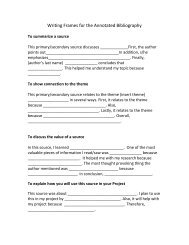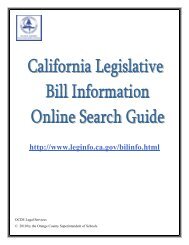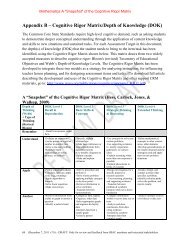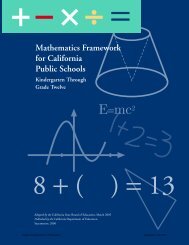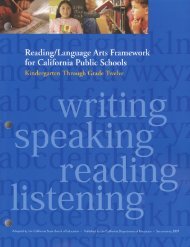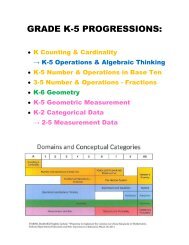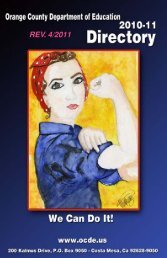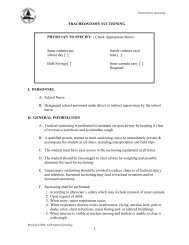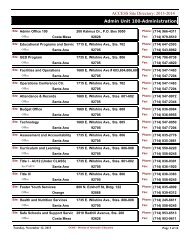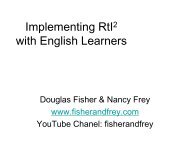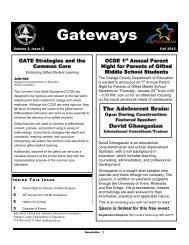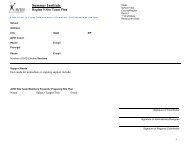The Promise and the Peril for Students with Disabilities - CalSTAT
The Promise and the Peril for Students with Disabilities - CalSTAT
The Promise and the Peril for Students with Disabilities - CalSTAT
Create successful ePaper yourself
Turn your PDF publications into a flip-book with our unique Google optimized e-Paper software.
This focusing of curriculum <strong>and</strong><br />
instruction is consistent <strong>with</strong> <strong>the</strong> assumptions<br />
<strong>and</strong> principles of response<br />
to intervention (RtI), which targets<br />
<strong>and</strong> differentiates instruction <strong>and</strong><br />
support based on students’ needs as<br />
it monitors <strong>the</strong>ir progress. Strategies<br />
may differ across <strong>the</strong> tiers of intervention,<br />
but all are focused on ensuring<br />
that students learn desired knowledge<br />
<strong>and</strong> skills.<br />
<strong>The</strong> National Center on<br />
Response to Intervention<br />
<strong>and</strong> its many resources can be found at<br />
www.rti4success.org/.<br />
RTI Action<br />
Network Videos<br />
from <strong>the</strong> Center on Instruction<br />
can be found at<br />
www.centeroninstruction.org/<br />
rti-action-network-videos.<br />
<strong>The</strong> CCSS help to ensure that those<br />
engaged in RtI are clear about what<br />
students are expected to know, underst<strong>and</strong>,<br />
<strong>and</strong> be able to do. <strong>The</strong>y help<br />
to identify <strong>the</strong> skills <strong>and</strong> knowledge<br />
that students need to attain in each<br />
grade. <strong>The</strong> CCSS also help to define<br />
<strong>the</strong> progression across <strong>the</strong> grades so<br />
that students do not find <strong>the</strong>mselves<br />
in a grade <strong>with</strong>out <strong>the</strong> knowledge<br />
<strong>and</strong> skills <strong>the</strong>y need because someone<br />
in an earlier grade decided to skip a<br />
skill, not knowing of its foundational<br />
importance <strong>for</strong> a subsequent grade.<br />
Helping parents (<strong>and</strong> students)<br />
know what is expected. Ano<strong>the</strong>r<br />
promise of CCSS is that parents will<br />
have a clear <strong>and</strong> consistent underst<strong>and</strong>ing<br />
of what <strong>the</strong>ir children are expected<br />
to know <strong>and</strong> be able to do. With this<br />
underst<strong>and</strong>ing, parents can take advantage<br />
of resources that schools, districts,<br />
<strong>and</strong> states provide to <strong>the</strong>m about<br />
<strong>the</strong> CCSS (see <strong>the</strong> resources on pages<br />
14–15 of this issue). In addition,<br />
when students are clear about what is<br />
expected of <strong>the</strong>m, <strong>the</strong>y have a greater<br />
chance of reaching <strong>the</strong>ir academic<br />
goals—<strong>and</strong> of leaving high school<br />
ready <strong>for</strong> college or a career.<br />
<strong>The</strong> <strong>Peril</strong> of <strong>the</strong> CCSS<br />
A great deal has to happen to realize<br />
<strong>the</strong> promise of <strong>the</strong> CCSS. And because<br />
of that, <strong>the</strong>re is peril associated <strong>with</strong><br />
<strong>the</strong>se st<strong>and</strong>ards. Some of <strong>the</strong> greatest<br />
challenges lie in areas that have been<br />
challenges be<strong>for</strong>e <strong>for</strong> students <strong>with</strong><br />
disabilities.<br />
Low expectations. <strong>The</strong> CCSS are<br />
rigorous <strong>and</strong> complex; <strong>the</strong>y are high<br />
st<strong>and</strong>ards that target what has to be<br />
learned at each grade so that students<br />
leave <strong>the</strong> K–12 system ready <strong>for</strong> a<br />
career or <strong>for</strong> college. In <strong>the</strong> past, low<br />
expectations <strong>for</strong> students <strong>with</strong> disabilities<br />
have reduced <strong>the</strong> content to which<br />
<strong>the</strong>se students have been exposed.<br />
<strong>The</strong>re is, however, a great deal that<br />
educators can do to avoid an attitude of<br />
low expectations. Ra<strong>the</strong>r than assume<br />
that students are not able to attain desired<br />
knowledge <strong>and</strong> skills, teachers can<br />
move <strong>for</strong>ward <strong>with</strong> “<strong>the</strong> least danger<br />
assumption”—one that expects high<br />
per<strong>for</strong>mance.<br />
A Challenge to Create a New<br />
Paradigm,<br />
by Cheryl Jorgensen, who discusses<br />
“<strong>the</strong> least dangerous assumption”<br />
can be found at<br />
http://sites.udel.edu/access/<br />
files/2012/03/Least-Dangerous-<br />
Assumption-by-C-Jorgensen.pdfAdd.<br />
Resources <strong>for</strong> IEPs<br />
are available from CDE at www.cde.<br />
ca.gov/sp/se/sr/iepresources.asp.<br />
presentation <strong>and</strong> multiple avenues of<br />
response. <strong>The</strong>y also include ensuring<br />
that students receive support from<br />
assistive technology devices. In addition,<br />
many students <strong>with</strong> disabilities<br />
will need accommodations to ensure<br />
access to <strong>the</strong> general curriculum (Bolt<br />
& Roach, 2009).<br />
A Parent Guide to<br />
Universal Design <strong>for</strong> Learning<br />
is at www.ncld.org/checklists-amore/parent-advocacy-guides/<br />
a-parent-guide-to-udl.<br />
Build an Assistive<br />
Technology Toolkit,<br />
by Kelly Ahrens, is at www.eric.<br />
ed.gov/PDFS/EJ954322.pdf.<br />
Access to assessments will be just as<br />
important as access to <strong>the</strong> curriculum.<br />
With <strong>the</strong> CCSS, states potentially are<br />
able to share assessments because <strong>the</strong>y<br />
all can be based on <strong>the</strong> same st<strong>and</strong>ards.<br />
At this point, five consortia of states<br />
are developing assessments, all based<br />
on <strong>the</strong> CCSS. Cali<strong>for</strong>nia is part of <strong>the</strong><br />
Smarter Balanced Assessment Consortium<br />
(SBAC; also see <strong>the</strong> article on<br />
page 3), which is developing a system<br />
of interim <strong>and</strong> summative assessments<br />
(see page 8 <strong>for</strong> highlights). It is critical<br />
that <strong>the</strong> developers of <strong>the</strong> common<br />
assessments think from <strong>the</strong> beginning<br />
about all students who will participate<br />
in <strong>the</strong>ir assessment systems <strong>and</strong> that<br />
<strong>the</strong>y include in <strong>the</strong>ir consortia—<strong>and</strong><br />
take advantage of <strong>the</strong> expertise of—<br />
educators who know <strong>and</strong> work <strong>with</strong><br />
students <strong>with</strong> disabilities.<br />
Thus, a student’s individualized<br />
education program (IEP) will need to<br />
include annual goals that focus on <strong>the</strong><br />
supports <strong>the</strong> student needs to build <strong>the</strong> Steps <strong>for</strong><br />
knowledge <strong>and</strong> skills necessary <strong>for</strong> college<br />
<strong>and</strong> career.<br />
To ensure that <strong>the</strong> promise of <strong>the</strong><br />
Educators to Take<br />
Failing to provide access. Access CCSS is realized, educators will need to<br />
to <strong>the</strong> curriculum is a critical part take a number of steps. Some of <strong>the</strong> big<br />
of ensuring that students attain <strong>the</strong> things to do <strong>and</strong> keep in mind are:<br />
knowledge <strong>and</strong> skills defined by <strong>the</strong> 1. Learn <strong>the</strong> CCSS! Find resources that<br />
CCSS (Nolet & McLaughlin, 2005). provide in<strong>for</strong>mation about <strong>the</strong> CCSS.<br />
Ensuring this access has many facets. Study materials from professional<br />
<strong>The</strong>se include universally designed associations <strong>and</strong> parent groups. Look<br />
instructional materials <strong>and</strong> approaches, at <strong>the</strong> CCSS Web site <strong>for</strong> materials<br />
ones that provide multiple avenues of <strong>The</strong> <strong>Promise</strong>, continued page 8<br />
<strong>The</strong> Special EDge u Summer 2012 <strong>The</strong> Common Core State St<strong>and</strong>ards u 7




